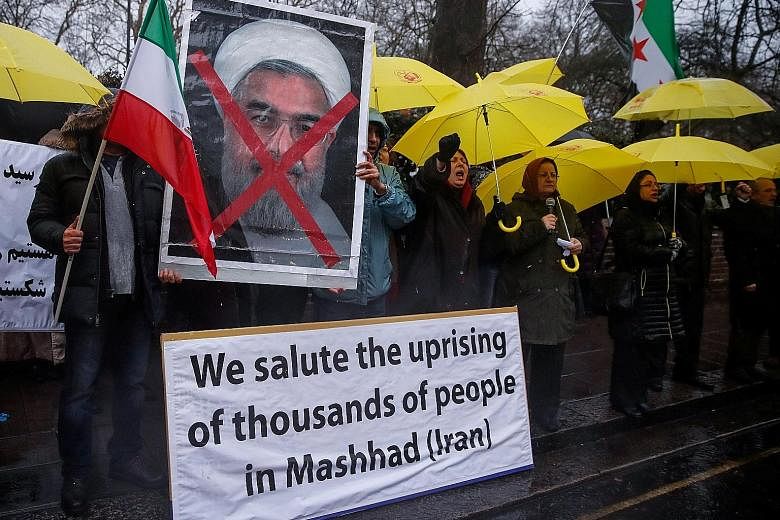TEHERAN • Ten people were killed overnight in the worst violence yet in Iran's protests, local media reported yesterday, while President Hassan Rouhani said the Iranian people would respond to "rioters and lawbreakers".
The nationwide protests have drawn tens of thousands of people and are the boldest challenge to Iran's leadership since pro-reform unrest in 2009. Calls for more demonstrations yesterday raise the possibility of prolonged instability.
"In the events of last night, unfortunately, a total of about 10 people were killed in several cities," state television said as it showed footage of damage from the protests.
Among those dead were six people who were killed in the western town of Tuyserkan after shots were fired, while a local lawmaker said two people had been shot dead in the south-western town of Izeh.
Mr Rouhani played down the unrest, saying: "This is nothing."
"Criticism and protest are an opportunity, not a threat. The nation will themselves respond to the rioters and lawbreakers," he said in a statement posted on the presidency's website.
"Our nation will deal with this minority who chant slogans against the law and people's wishes, and insult the sanctities and values of the revolution."
-
How the protests spread in cities
-
MASHHAD
A few hundred demonstrators gathered in Mashhad and several other towns in Iran last Thursday to protest against high prices after a call reportedly goes out on the Telegram social messaging service.
Videos show protesters focusing their ire on the moderate President, but there were also slogans lambasting the Islamic regime and Iran's involvement in Middle East conflicts.
TRUMP WARNING
The next day, larger-scale protests flared up in more cities, including Kermanshah and key religious centre Qom. Footage showed demonstrators chanting "Death to the dictator" and "Free political prisoners".
United States President Donald Trump waded in on Twitter, insisting that the Iranian authorities "respect their people's rights" and warning Teheran that "the world is watching".
DEADLY CLASHES
Last Saturday, regime supporters rallied around the country for officially sanctioned demonstrations to mark the defeat of the 2009 protest movement.
Protests grew in Teheran as scuffles broke out at the city's main university.
An official confirmed that two people were killed in the western town of Dorud during an "illegal protest" last Saturday evening, but insisted security forces did not fire on the crowd.
DEATHS AS CALM URGED
On Sunday, Interior Minister Fazli warned that those who "damage public property, disrupt order and break the law" will "pay the price".
Officials said 200 people were arrested during the demonstrations in Teheran and another 80 in Arak, some 300km away.
President Hassan Rouhani broke his silence, insisting people are "absolutely free" to express their anger.
Yesterday, Iranian media and officials reported that 10 people died in protests overnight.
AGENCE FRANCE-PRESSE
The authorities did not give details on who was responsible for the fatal shootings.
Videos spread on social media of demonstrations in several towns and cities, including Kermanshah, Khorramabad and Shahinshahr.
A school for the clergy and government buildings were torched in the north-western town of Takestan, and videos showed police using tear gas and water cannon to disperse a small protest in Teheran's Enghelab Square on Sunday evening.
The authorities have confirmed more than 400 arrests.
Verifying rumours and videos remained challenging due to travel restrictions and sporadic blocks on mobile Internet and popular social media sites, including Telegram and Instagram.
The protests began as demonstrations against economic conditions in second city Mashhad last Thursday but quickly turned against the Islamic regime as a whole, with thousands marching in towns across Iran to chants of "Death to the dictator".
Mr Rouhani sought a conciliatory tone on Sunday, saying that government bodies "should provide space for legal criticism and protest", and calling for greater transparency and a more balanced media.
US President Donald Trump, a fierce critic of Teheran, said the "big protests" showed people "were getting wise as to how their money and wealth is being stolen and squandered on terrorism".
He accused Iran of "numerous violations of human rights", adding it "has now closed down the Internet so that peaceful demonstrators cannot communicate. Not good!".
Mr Rouhani dismissed Mr Trump's comments, saying the US President had no right to sympathise with Iranians since he "called the Iranian nation terrorists a few months ago".
After initial silence, state media began showing some footage of the demonstrations on Sunday, focusing on young men attacking banks and vehicles, an attack on a town hall in Teheran, and images of a man burning the Iranian flag.
There have been reminders of continued support for the regime among conservative sections of society, with pro-regime students staging sizeable counter-demonstrations at the University of Teheran over the weekend.
Mr Rouhani came to power in 2013 promising to mend the economy and ease social tensions, but high living costs and a 12 per cent unemployment rate have left many feeling that progress is too slow.
"We have no problem bigger than unemployment. Our economy needs an operation. We must all stand together," Mr Rouhani said yesterday.
The latest protests are the biggest since unrest in 2009 that followed the disputed re-election of then-President Mahmoud Ahmadinejad.
AGENCE FRANCE-PRESSE, REUTERS


